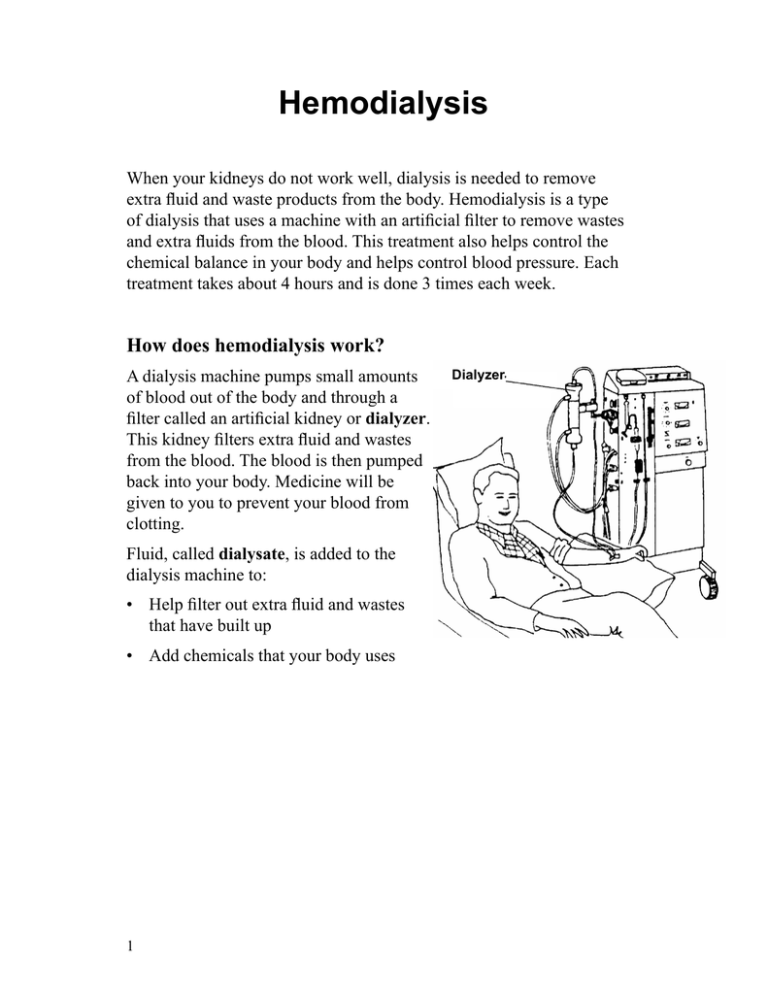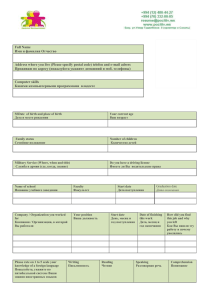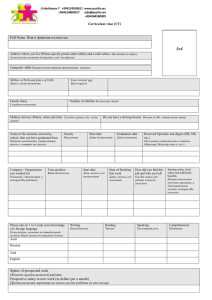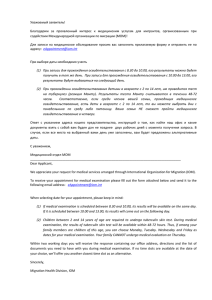Hemodialysis - Russian - Health Information Translations
реклама

Hemodialysis When your kidneys do not work well, dialysis is needed to remove extra fluid and waste products from the body. Hemodialysis is a type of dialysis that uses a machine with an artificial filter to remove wastes and extra fluids from the blood. This treatment also helps control the chemical balance in your body and helps control blood pressure. Each treatment takes about 4 hours and is done 3 times each week. How does hemodialysis work? A dialysis machine pumps small amounts of blood out of the body and through a filter called an artificial kidney or dialyzer. This kidney filters extra fluid and wastes from the blood. The blood is then pumped back into your body. Medicine will be given to you to prevent your blood from clotting. Fluid, called dialysate, is added to the dialysis machine to: • Help filter out extra fluid and wastes that have built up • Add chemicals that your body uses 1 Dialyzer Гемодиализ Если Ваши почки работают недостаточно хорошо, для удаления излишней жидкости и продуктов жизнедеятельности из Вашего организма Вам необходим диализ. Гемодиализ – это разновидность диализа, при котором для удаления отходов и излишней жидкости из крови используется аппарат с искусственным фильтром. Такое лечение также помогает осуществлять контроль химического баланса и кровяного давления в Вашем организме. Каждый сеанс лечения занимает около 4 часов, и выполняется еженедельно 3 раза в неделю. Как работает гемодиализ? Диализный аппарат откачивает небольшие количества крови из организма и пропускает их через фильтр, который называется искусственной почкой или диализатором. Эта почка фильтрует излишнюю жидкость и отходы из крови. Затем кровь закачивается в Ваш организм. Для предотвращения свертывания крови Вам дадут лекарство. Диализатор Жидкость, которая называется диализатом, добавляется в диализный аппарат с целью: • Фильтрации накопившейся излишней жидкости и отходов • Добавления химических веществ, необходимых Вашему организму Hemodialysis. Russian. 1 The dialysate is a mixture of water and chemicals that are present in your blood. This fluid can be adjusted, based on your lab values, to give you the best filtering with fewer side effects. Dialyzer For your safety, the machine has pumps, sensors, monitors and alarms to let the staff know if there is any problem. Access Site For this treatment, there needs to be a site where the blood is taken out of the body and then returned to the blood stream. This is called an access. After the access is made and healed, 2 needles connected to tubing are inserted into the access. One needle draws a small volume of blood out and pumps it through to the dialysis machine and filter. After the blood is filtered, it is return to the body through the other needle. There are three main types of access sites: • Fistula – With minor surgery, an artery in the arm is joined to a vein under the skin. This increases the amount of blood that flows through the vein, and makes it bigger. This is the best access because it has fewer complications and lasts longer. • Graft – With minor surgery a soft plastic tube is used to join the artery and vein under the skin. This is done when a fistula is not the best method for your care. A graft needs at least 2 weeks to heal before it can be used for dialysis. 2 Диализат – это смесь воды и химических веществ, которые содержатся в Вашей крови. Состав этой жидкости может быть отрегулирован в соответствии с результатами Ваших лабораторных анализов для того, чтобы достичь наилучшей фильтрации при наименьших побочных явлениях. Диализатор Для Вашей безопасности в аппарате есть насосы, датчики, мониторы и устройства аварийной сигнализации для извещения служебного персонала в случае возникновения какой-либо проблемы. Место подключения Для этого лечения должно существовать место, в котором производится забор крови из организма, и через которое она затем возвращается в кровеносную систему. Это называется местом подключения. После того как место подключения подготовлено и зажило, в это место вводятся 2 иглы, которые подсоединяются к трубкам. Через одну иглу осуществляется забор небольшого количества крови, которая прокачивается через диализный аппарат и фильтр. После фильтрации кровь возвращается в организм через другую иглу. Существует три основных типа мест подключения: • Свищ – с помощью небольшой хирургической операции артерия подсоединяется к вене под кожей. Это чаще всего делается на руке. При этом увеличивается количество крови, протекающей через вену, и она становится больше. Это самое лучшее место подключения, потому что с ним меньше трудностей, и оно может использоваться дольше. • Имплантат – с помощью небольшой хирургической операции мягкая пластиковая трубка подсоединяется к артерии и вене под кожей. Это делается, когда свищ является не самым лучшим методом для Вас. На заживление тканей вокруг имплантата требуется не менее 2 недель, прежде чем его можно использовать для диализа. Hemodialysis. Russian. 2 • A catheter – There are two kinds of catheters, temporary and permanent. The temporary catheter is used for 1 to 2 weeks. This catheter is used until a more permanent access is placed. A permanent catheter is placed in the neck vein and tunneled under the skin. The catheter has a risk for infection and is used only until a fistula or graft can be placed. Both the fistula and graft need 2 to 6 weeks to heal and mature before they are able to be used. Side Effects of Hemodialysis During treatment you may: • Feel tired and sleepy • Feel dizzy • Be cold • Have muscle cramps • Have nausea Let the staff know how you are feeling so that they can help you be more comfortable. After dialysis, it is normal to feel tired so plan to rest. Other Care • You will feel changes in your body as the waste and fluids build up between treatments. • Follow your diet and fluid restrictions to limit severe changes between treatments. 3 • Катетер – существует два вида катетеров, временный и постоянный. Временный катетер используется от 1 до 2 недель. Этот катетер используется до тех пор, пока не будет сделано более постоянное место подключения. Постоянный катетер подключается к шейной вене и размещается под кожей. Через катетер может попасть инфекция, поэтому он используется до тех пор, пока не появится возможность размещения свища или имплантата. Свищ и имплантат заживают от 2 до 6 недель, и только после этого их можно использовать. Побочные явления при гемодиализе Во время лечения: • Вы можете почувствовать усталость или сонливость • Вы можете испытывать головокружение • Вам может быть холодно • У Вас могут быть спазмы мышц • Вас может тошнить Сообщите персоналу о своем самочувствии, чтобы они могли помочь Вам устроиться более комфортно. Обычно после диализа пациенты испытывают чувство усталости, поэтому необходимо запланировать себе отдых. Другой уход • Вы будете чувствовать изменения в организме по мере того, как в промежуток времени между лечениями будут накапливаться отходы и жидкость. • Соблюдайте диету и ограничения приема жидкости для уменьшения значительных изменений между лечениями. Hemodialysis. Russian. 3 • The human kidney makes a hormone called erythropoietin. This hormone is needed to produce red blood cells and vitamin D. Without it, your body cannot absorb calcium from foods and your bones can become weak. Medicine can be given to help replace this hormone. • The human kidney also helps control blood pressure and salt balance in your body. It is common to be on medicines to treat high blood pressure. Talk to the staff if you have any questions or concerns. 2008 – 6/2012 Health Information Translations Unless otherwise stated, user may print or download information from www.healthinfotranslations.org for personal, non-commercial use only. The medical information found on this website should not be used in place of a consultation with your doctor or other health care provider. You should always seek the advice of your doctor or other qualified health care provider before you start or stop any treatment or with any questions you may have about a medical condition. The Ohio State University Medical Center, Mount Carmel Health System, OhioHealth and Nationwide Children’s Hospital are not responsible for injuries or damages you may incur as a result of your stopping medical treatment or your failure to obtain medical treatment. 4 • Человеческая почка вырабатывает гормон, который называется эритропоэтин. Этот гормон необходим для выработки красных кровяных телец и витамина D. Без него организм не может поглощать кальций из пищи, и Ваши кости могут потерять прочность. Для замещения этого гормона Вам могут дать лекарство. • Кроме того, человеческая почка помогает контролировать кровяное давление и солевой баланс в Вашем организме. Обычно для лечения повышенного кровяного давления принимают лекарства. Если у Вас есть какие-либо вопросы или опасения, обратитесь к медицинскому персоналу. 2008 – 6/2012 Health Information Translations Unless otherwise stated, user may print or download information from www.healthinfotranslations.org for personal, non-commercial use only. The medical information found on this website should not be used in place of a consultation with your doctor or other health care provider. You should always seek the advice of your doctor or other qualified health care provider before you start or stop any treatment or with any questions you may have about a medical condition. The Ohio State University Medical Center, Mount Carmel Health System, OhioHealth and Nationwide Children’s Hospital are not responsible for injuries or damages you may incur as a result of your stopping medical treatment or your failure to obtain medical treatment. Hemodialysis. Russian. 4




